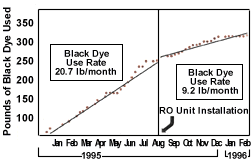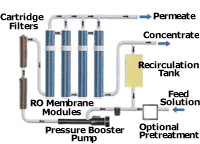Reverse Osmosis in Finishing
Results of a pollution prevention project between a finishing company and the EPA...
Reverse osmosis (RO) involves separating water from a solution of dissolved solids by forcing water through a semi-permeable membrane. As pressure is applied to the solution, water and other molecules with low molecular weight (less than 200 g/mole) pass through micropores in the membrane. Larger molecules, such as organic dyes and metal complexes, are retained by the membrane. RO membrane systems feature crossflow filtration to allow the concentrate stream to sweep away retained molecules and prevent the membrane surface from clogging or fouling.
In the past, RO applications for electroplating operations were mostly limited to final treatment of combined wastewater streams. Such applications typically involved discharging permeate to a POTW and returning the concentrate to the head of the wastewater treatment system. Because of the high flow rates associated with treating combined wastewater streams, large, costly RO units were required. More recent applications in metal finishing involved installing RO units in specific process operations, allowing return of the concentrate to the process bath and reuse of permeate as fresh rinse water.
Featured Content
By closing the loop, valuable process chemicals are recovered and less fresh water is needed. Furthermore, a waste stream is eliminated that would otherwise be discharged to the POTW. RO systems have been successfully applied to a variety of finishing operations, including several types of copper, nickel and zinc electroplating; nickel acetate seal; and black dye.
RO unit components. Figure 2 shows a basic RO unit. The essential components include a strainer, a pressure booster pump, cartridge filter and the RO membrane modules. The strainer removes large, suspended solids from the feed solution to protect the pump. The booster pump increases the pressure of the feed solution. Typical operating pressures range from 150 to 800 psi. Commercially available cartridge filters are used to remove particulates from the feed solution that would otherwise foul the units. Filter pore sizes are typically between one and five microns.
Membranes are assembled in molecules that compact a membrane of large surface area within a cylindrical shell of small volume. The spiral-wound module is most applicable to finishing. Although a number of membrane materials are under development, two commercially available membrane materials are currently in common use: aromatic polyamides and cellulose acetate. The aromatic polyamide membranes used in spiral-wound modules typically take the form of thin-film composites. Such a membrane consists of a thin film of membrane bonded to layers of other porous materials that support and strengthen the membrane. Thin-film composites can be applied over a relatively broad pH range (2 to 11), can tolerate a maximum temperature of about 115F and are more durable than single-material membranes.
Cellulose acetate membranes are limited to a narrow pH range (2.5 to 7) and a lower maximum temperature, about 85F. These membranes are biologically degradable.
The type of RO membrane and module needed depends on feed solution characteristics and the desired performance of the RO unit. RO vendors or consultants often select an off-the-shelf unit that is most appropriate for a given application. Pilot tests are often necessary before a full-scale RO system is implemented.
| TABLE I—Specifications of Ecosystems Black Dye RO Unit | |
| Unit Size: | Footprint: 2 ft by 3 ft, Height: 5 ft |
| Power: | 3 Phase, 110/240 VAC, 3 hp |
| Feed Rate: | 3 gpm |
| Operating Pressure: | 150 to 180 psi |
| pH Range: | 4 to 8 |
| Max. Temperature: | 115F |
RO unit operation and maintenance. RO unit operation involves adjusting valve and pump settings to control the pressure and flow rates of the feed and concentrate streams. The most significant RO maintenance requirement is membrane cleaning or replacement because of fouling. Membrane fouling results from poor feed-solution characteristics that are controlled largely by pretreatment. When fouling is prevented or minimized by effective pretreatment, RO unit maintenance requirements are minimal.
Cost considerations. The capital and installation cost for an RO unit is highly application specific. However, an RO unit used for an electroplating application involving low influent rates (three to five gpm) and little pretreatment can cost $10,000 or less. The basic cost covers the strainer, pressure booster pump, cartridge filters, RO membrane modules, plumbing and installation. The capital cost of an RO system is also impacted by the amount of pretreatment required. Many RO units are compact and have low space requirements, reducing installation costs. Operation and maintenance costs associated with RO units are relatively low. Energy costs are typically low because the only energy needed is for pumping. However, energy costs increase if UV disinfection and temperature adjustment are required. Because RO units are automated, little operator attention is needed and labor costs are typically low. Maintenance costs are driven by membrane cleaning and replacement schedules that are determined by influent characteristics and pretreatment effectiveness.
RO application case study. The Merit Partnership sponsored a P2 project involving RO at the Danco Metal Surfacing facility in Ontario, CA. The objective was to assess the impact of applying RO to metal finishing operations. The 10,000-sq-ft Danco facility employs 30 people and operates two shifts per day. Danco anodizes small- to medium-sized parts such as screws, flashlight parts and bicycle frames.
Facility anodizing operations include cleaning, etching, anodizing (sulfuric-acid based), chromate conversion, several types of dying and nickel acetate and hot water sealing. An RO unit developed by Ecosystems, Costa Mesa, CA, was installed in the nickel acetate sealing operation and another was installed on the black dye operation. These units feature closed-loop configurations that return reclaimed rinse water to the rinse baths and return concentrated process chemicals to the process baths.
When the RO units were installed, Danco replaced its single-stage rinses with two-stage counterflow rinses to reduce the rinse water flow rates. In each operation, the rinse water that overflows the first-stage rinse tank is pressurized by a high-pressure feed pump. Particulates are removed from the feed solution by two, one-micron cartridge filters. The feed solution then flows in series through spiral-wound modules containing thin-film composite RO membranes. There are two modules for nickel acetate and four for the black dye operation.
After separation, a portion of the concentrate stream is returned to the process bath to recover valuable chemicals. The remaining portion of the concentrate stream is conveyed to the recirculation tank where it is temporarily stored before being recirculated through the RO unit. Permeate is conveyed to the second rinse tank and is reused as clean rinse water. Fresh DI water is added to the process baths to make up for evaporation.
Feed pretreatment required by the nickel acetate RO unit includes UV disinfection. The black dye RO unit does not require feed disinfection because the black dye inhibits microorganism growth. After a few months of RO unit operation, oil and grease separation in the black dye rinse water fouled the RO membranes. Danco and Ecosystems eliminated this problem by changing the location of the feed solution intake from the surface of the rinse tank to the center of the tank.
| TABLE II—Black Dye RO Unit Results | |||
| Before | After | Monthly Savings | |
| Black Dye Use | 20.7 lb/mo. | 9.2 lb/mo. | $293 |
| City Water Use | 3 gpm | 0 gpm | $83 |
| Wastewater Discharge | 3 gpm | 0 gpm | $133 |
| Annual Savings: $6,111 Payback Period: about 2 years |
|||
Impact of black dye RO unit at Danco. Because limited data are available on the nickel acetate operation before RO unit installation, the performance of the black dye RO unit is featured in this case study. Black dye use decreased significantly after installation. These results are particularly noteworthy considering that Danco's production rate increased about 50% two months before the unit was installed.
Table II summarizes the material purchase and waste disposal reductions and savings. Savings include black dye and city water costs and wastewater discharge fees. The black dye solution contains about 300-ppm trivalent chromium. Before the RO unit was installed, black dye rinse water containing trivalent chromium was discharged to the local POTW for treatment. This wastewater stream was eliminated as a result of RO unit installation.
Contaminants in the black dye rinse water, such as chloride, sulfate and metals, may slowly accumulate in the process bath as they are retained by the RO membranes and recycled to the process bath in the concentrate. Danco personnel report no adverse impacts on the quality of finished parts since the installation. Also, at another Danco facility where RO has been used in a similar black dye operation for more than a year, personnel observed no adverse impacts on process quality.
Anecdotal information regarding the nickel acetate RO unit indicates similar performance in terms of raw material use reduction, cost savings and no adverse impacts on process quality.
Black dye RO unit costs. Cost information was obtained from invoices, utility bills and other information obtained from Danco and the supplier. The capital and installation costs for the black dye unit was $10,000. Operation and maintenance costs include power, membrane cleaning and cartridge filter replacement. Power costs are estimated to be about $105 per month, based on Danco's current production schedule. The membrane requires periodic cleaning; however, cleaning costs, including supplies and labor, are negligible. Cartridge filters are replaced every two to four weeks at an average cost of $12 per month. The life of the RO membrane in the black dye unit is unknown. Therefore, potential membrane replacement costs were not included in the payback period calculation. Also, the payback period calculation did not include RO unit depreciation. PF






















